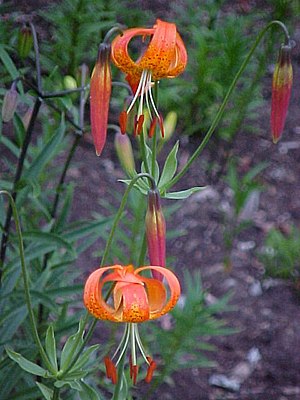Panther lily
| Panther lily | ||||||||||||
|---|---|---|---|---|---|---|---|---|---|---|---|---|

Panther lily ( Lilium pardalinum ) |
||||||||||||
| Systematics | ||||||||||||
|
||||||||||||
| Scientific name | ||||||||||||
| Lilium pardalinum | ||||||||||||
| Kellogg |
The panther lily ( Lilium pardalinum ) is a species of the genus of lilies ( Lilium ) in the American section .
description
The panther lily reaches a height of between 100 cm and 230 cm. The bulbs are round, they consist of yellowish-white scales and form rhizomes .
The stem is smooth and straight, the leaves lanceolate, between 4.9 and 26.5 cm long and between 0.3 and 5.6 cm wide. They are bent downwards in one to six wreaths of 3 to 19 leaves arranged around the stem or distributed around it, the leaf margins papilous .
The plant blooms in August with 10 to 20 nodding, non-fragrant flowers in a panicle . The flowers consist of six backward-rolled petals 3.5 to 10.4 cm long and 0.9 to 2.2 cm wide ( turkish collar shape ). There are three crown- and three sepals , but look very similar. The basic color of the flowers is bright yellow-orange, merging into red towards the tip with brown points in the yellow area. The anthers and pollen are chocolate brown and the filaments greenish-white.
The seeds ripen in oval 22-57 mm bolls zoom. The seeds of the panther lily germinate with a delay - hypogeic after a warm / cold / warm cycle.
The number of chromosomes is 2n = 24.
distribution
This species is endemic to California and Oregon in the United States .
The panther lily grows in colonies with a relatively small specific habitat, often near rivers.
Systematics
In addition to the nominate form, there are also subspecies:
- Lilium pardalinum subsp. pitkinense (Beane & Vollmer) MWSkinner : pollen red or brown-orange, anthers magenta, bulbs usually segmented into two parts, distribution area: near the coast, especially around Sebastopol (California) , there in marshland. The subspecies is critically endangered and one of the rarest lily taxa ever, the number of still existing individuals is estimated at only around 300.
- Lilium pardalinum subsp. shastense (Eastw.) MWSkinner : pollen yellow or light orange, anthers orange to magenta, onions segmented into two or four parts, common area: northern California and southern Oregon.
- Lilium pardalinum subsp. Vollmeri (Eastw.) MWSkinner : very long, narrow leaves, flowers somewhat smaller, pollen dark orange, distribution area: northwestern California and southern Oregon.
- Lilium pardalinum subsp. wigginsii (Beane & Vollmer) MWSkinner : flowers monochrome yellow, also anthers and pollen yellow, distribution area: northern California and southern Oregon.
Not a real variety is:
- Lilium pardalinum var. Giganteum Stearn & Woodcock : larger plant, up to three meters, with up to 50 flowers. This putative variety was identified by Jacob Whitman Bailey as a hybrid between Lilium pardalinum and Lilium humboldtii .
cultivation
The onion of the panther lily is edible, it is rich in starch and can be cooked in a similar way to the potato . It was mainly baked and consumed by the Atsugewi , Karok and Yana in an earth oven .
swell
literature
- Mark W. Skinner: Lilium canadense . In: Flora of North America . tape 26 . Oxford University Press, Oxford 2003, ISBN 978-0-19-515208-1 , pp. 188 ( [2] [accessed February 2, 2009]).
Individual evidence
Web links
- Markus Hohenegger: Lilium pardalinum. In: The Genus Lilium. Retrieved February 2, 2010 .